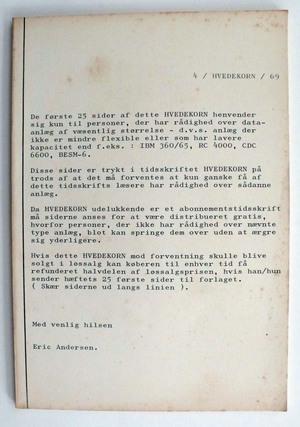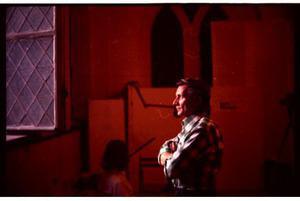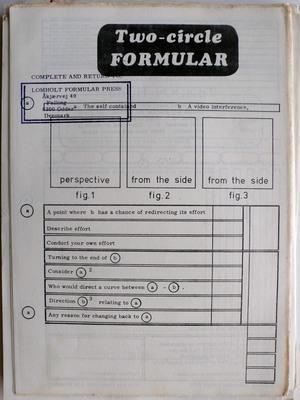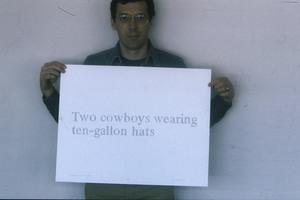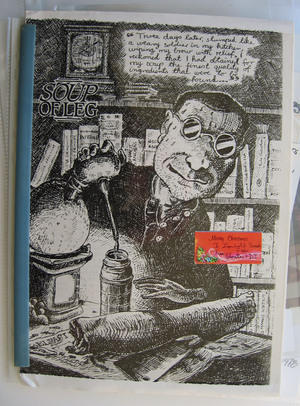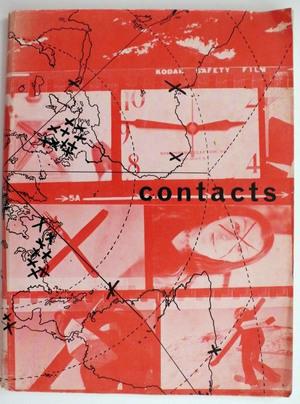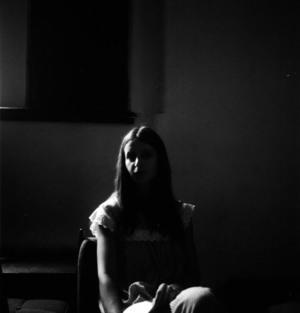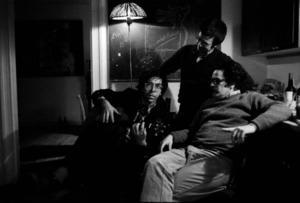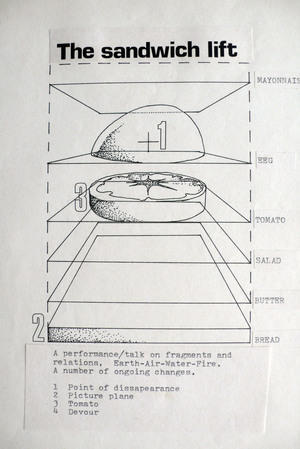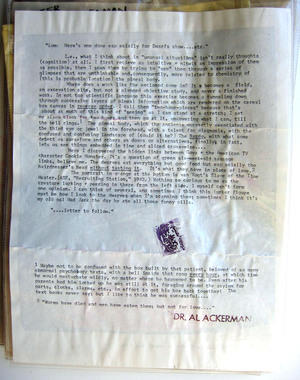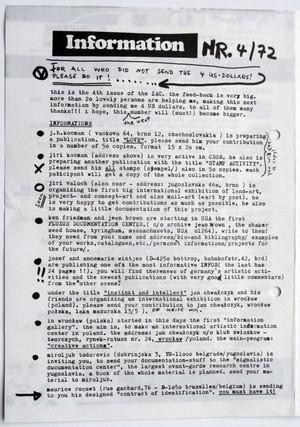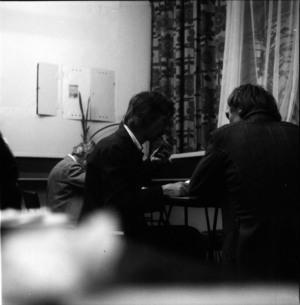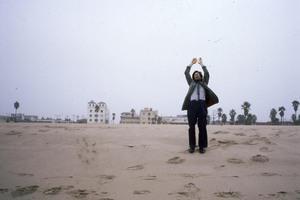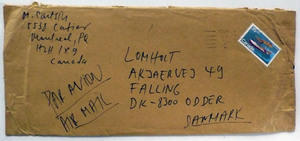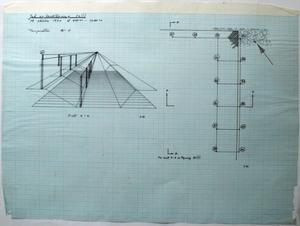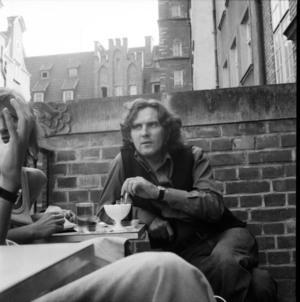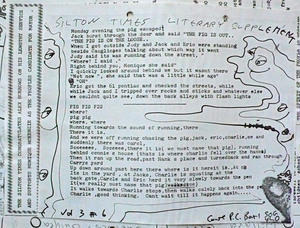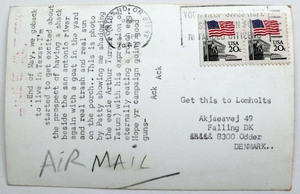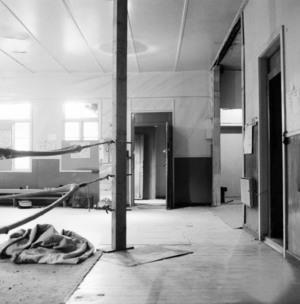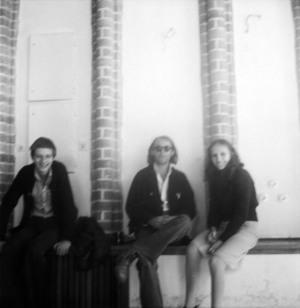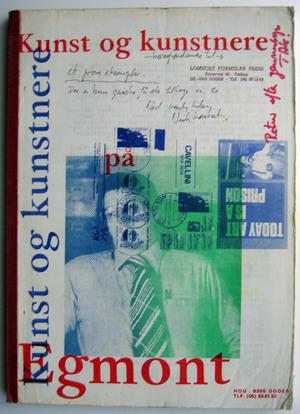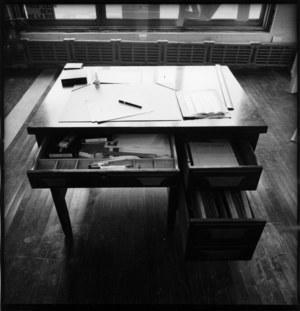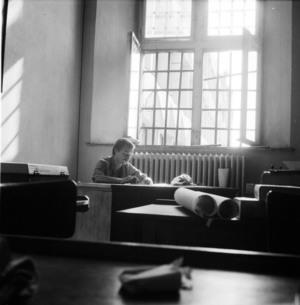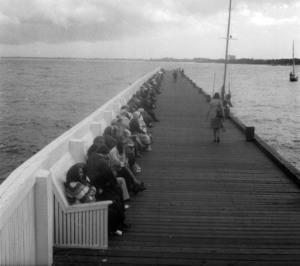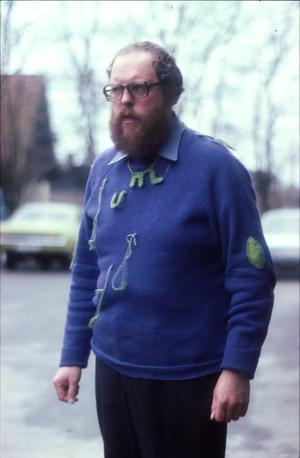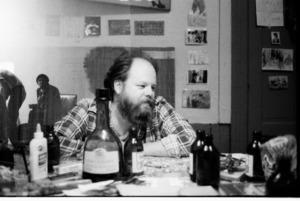In and Out of Mail Art
By Niels Lomholt
Mail Art was not on my mind returning to Denmark in 1969 after five years abroad.
five years of confrontation with almost all that moved in art in the 60’s. Lessons with Claes Oldenburg, Richard Hamilton an afternoon in the same house as Marcel Duchamp, Conceptual Art, Joseph Kosuth, Art & Language and Pop Art as far as the eye reached. Staying abroad was an art education.
No wonder the head was spinning in 1969.
A few things lightened up on the Danish Art scene in ‘69.
A brief contact with Eric Andersen, lead to other contact with Bill Vazan and Klaus Groh. Their work and methods was a direct ticket to Mail Art.
Klaus Groh’s IAC Bulletins announcing projects and addresses world wide, soon developed into a daily practice of Mail Art. The challenge was to work out what to put into the network.
My work around 1970 was a kind of conceptual Land Art. This work was transformed into postal size. Soon the work became more photographic and documentary.
My first big leap in the Mail Art Network, apart from the daily practice of Mail Art, came in 1975, with an invitation to participate in an artist meeting in Gdansk Poland. I had been working on a project around the boxer’s dressing room: “The Trans-Quiet Dressingroom”, documentary photos, texts and a number of artworks.
I took this project to Gdansk.
A number of East-European artist were present: Andrzej Partum, Ewa Partum, Ian Swidzinski, Endre Tót, Goran Trbuliak and Jean Sellem from Sweden. The East European approach to art was astonishing, a presence to the bare bones.
Their work was very conceptual, just a little more human, reflecting their social and political situation.
It was time to find a personal way in and out of Mail Art.
Lomholt Formular Press, 1975 – 1985
Gdansk, Poland, October 1975.
On a pier
A long row of Polish families and pensioners on a strip of land formerly known as Danzig, occupied by a Soviet mentality, waiting for a ray of sunlight on a grey October day. What passed through the body and mind of this static installation?
A sense of form and structure for good or bad, to make ideas meet the complexity of life.
Lomholt Formular Press (LFP) started to take shape.
The LFP’s task was clear: a formal piece of A4 paper, classifying and categorizing points of view, hope, anger, wishes and frustration. There was little room for the formal qualities of ART.
A final persuasion!
In Gdansk all the invited artists stayed in a student tower block, not too old, lots of concrete, falling apart. The art life was wonderful, parties, music (there was a band from Turkey), vodka and interesting people, nobody cared about concrete.
An early morning, at sunrise, I went to the pissoir on the 9th floor. Above the pissoir was a window with a magnificent view overlooking Gdansk. These are the moments you forget yourself. A sudden feeling of wet shoes brought me back to the tower block reality. The pissoir drain was disconnected and pointed right at the costumers’ feet.
The foundation for LOMHOLT FORMULAR PRESS was laid on the challenge from social and physical order, hope, lust and deliverance.
4 years later
3 ways in and out of Mail Art and the parallel movements.
I have only met Zack on two occasions in 1979 and 1980, but our correspondence runs over nearly fifteen years.
In 1972 I participated in Bill Vazan’s Montreal: Project X – meeting points.
Zack send a letter and contact was established.
1972 was a year of Pop art, Conceptualism, Minimalism, drugs and Rock’ Roll, and political art. Correspondence and Mail Art were mediums to find new ways, new networks, and new doors. The Mail Art network attracted many new practitioners and activities outside the sometimes rather claustrophobic art circles
Zack's writings, attitude and projects reflected that mood, a fascinating flow of stories and language like water drilling holes into subject matter and cutting corners. Different angles on observations, jump cuts, and long passages of bare surface. The Zack style was something between the Oracle of Delphi and a Shaman’s chant.
Zack said: It’s good to be square, then you can see from all four corners.
There is a world of writing from letters to newspapers and everything in between, Zack’s writing was something else that gave voice to a well known, but rarely described feeling, short comments on all kind of situations, events, intimate details from an artist’s life in USA, a stream of conscious unmarked by moral, political correctness or any other limiting factor, just a stream of possible thoughts and words.
At that time I was working on a project: LOMHOLT FORMULAR PRESS, a way of structuring the impossible and connecting contradictionary statements into a, so-called, form. Zack understood this concept instinctive and in no time Zack had formed his own correspondence formula society, leaving novelists, poets, journalists to their own fate.
In 1979, at the time when the American hero Jim Jarmush was shooting his first film “Permanent Vacation”. I was teaching at a Danish folk highschool. After eight to nine years of correspondence it was time to meet some of the Mail Art friends. It was setup as six residencies of each two weeks. The following artists were invited: Cavellini, Italy; Ulisses Carion, Holland; Robin Crozier, England; Horacio Zabala Brazil; Davi Det Hompson, USA; and David Zack, USA. All but Cavellini came.
Zack arrived on my birthday the 17th of February 1979; he was to take over from Zabala.
Zack got right into the birthday cake with his long guitar nails, but only the creamy part of the cake, to my children’s amazement, breaking sacred rules and not being told of. Then the ukulele came out and a long chant on Zabala, Zabala, Zabala followed that carried on long into the night.
The Zack relationship had taken a new turn. New perspectives were to follow.
Zack performed, talked, made music alone or with the students, told stories, played the extraterrestrial oracle from Delphi and made collages. Twisting and turning, dancing and stinging like a bee, the art world answer to Muhammad Ali
The visit in 1979 demonstrated the close relationship between Zack’s words and living, endless talking, sound making, collages running up and down over his surroundings, a warped mirror.
Two events that stand out from Zacks visit to Denmark
In 1979 I was playing an Ornette Coleman inspired alto saxophone. Zacks approach to music became a great inspiration, not so much his music or his musical skill but the way music always popped up or how an event, sentence or a word suddenly became a song/sound, the fragmented flow of classical music, pop, blues, William Blake, cello or self-invented sounds moved in and out of small talk, stories, philosophy on the Monty Cantsin concept – at other times it would go into long monotonous streams of words like “Zabala, Zabala, Zabala”, “art is a prison Zabala, Zabala” etc. or as a Cavellini “song”.
What it lacked in musical quality it gained in flexibility and dialogue. It was not “hey, play a tune” but mingling with the world, participation, dialogue, twisting and turning language and statement.
On the 3rd of March we went on a three-hour drive to pick up Robin Crozier and his wife at the ferry from England. The plan was to plaster the walls of the waiting room, and ourselves, with Cavellini stickers, delivered by the artist himself. In that way Cavellini would be present in some form, and we would then welcome the Croziers with Zack’s music for voice, ukulele and flute. The trip to the ferry went well, Zack sat in the back making up and playing a Cavellini song, which most consisted of the word Cavellini, a kind of Buddhist mantra. At the ferry waiting room, everything went well even the police helped putting up the Cavellini stickers, at their own request. Unfortunately the Crozier ferry were three hours late which spoiled the inspiration a little, but all together it was a good song and Zack performance.
The other episode that stands out, banal as it is, but throwing a light flash on the political situation of socializing and moral, that was on the sunset horizon.
As our behaviour of political correctness at that time (a mix of Christ and Marx) were to be exchanged, American values meet Europe, and food were the metaphor here.
A lunch in Denmark 1979, is serving “Smoerrebroed”; bread, butter, egg, tomato, paté, herring, etc. on top.
The transcendental sandwich.
“Smoerrebroed” is a classic event with rigid rules of what to mix and what follows what. It became very clear from the first day that Zack was unaware of the basic rules of this food game. But as “when in Rome do as the Romans” I took upon me to enlighten Zack of the local tradition.
On the second day, when Zack came to the table, with his plate loaded with a mix of herring, pate, jam, sauce, cheese, bacon all in one pile, I thought this is the time to start lesson one.
A carefully choreographed plate with bread and herring and egg, was the first step. I had rehearsed this lecture, the need was anticipated and the lecture was detailed and fairly long. But before I had warmed up, Zack looked at me and said “Niels, I have given up on criticism”. This may not be the most earthshaking news that some American nut-artist brought to the European table, but it came at the perfect time. The protest against the Vietnam war was gone but not forgotten, cold war was still hot, sex drugs and rockn’ roll was on, the 70’s were a time of change. The food on the plate had to be addressed in a new way.
It became very clear to me that Zack was on to something. I had worked in Mail Art for some seven years, intrigued by the Mail Art Networks focus on political and social activities, my work had been based on a European art approach. The Zack-plate made me realize the necessity of a change in attitude. Not just a change of artistic material like paint, Ready Made or found objects. The European intellectual state of affairs was an analysis down to the smallest details in philosophy, literature, art and film, and a strong disbelief in the old Freudian saying: “Sometimes a cigar is just a cigar”. Pop Art, together with other artforms, made an assault on this kind of detailed analysis.
This is where the Zack genius lays, the organic and coherent existence within the modern and the American way of life.
Zack turned up again in autumn 1980 in Los Angeles
The line of small miracle continued.
After a month together with Monty Cantsin in Montreal the plan was to do US by Grey Hound and fly home from Vancouver.
The trip was planned with several stops on the way seeing old friends and two weeks in Los Angeles to see Zack. To confirm this arrangement I called Zack several times en route, but no answer. I was getting a little worried that our arrangement didn’t hold and I would have to find other lodgings in LA. The bus stopped in Las Vegas around midnight and I called Zack. A lady answered the phone and, running out of coins, I asked if she would make a collect call, which she refused and hung up. No contact.
07:00 in the morning the bus arrived in Los Angeles. All alone, no fun. To think it over I went for a cup of coffee. The worst coffee I have ever tasted. A man, who had the same coffee poured it over the waitress’ head. Welcome to Los Angeles! Fortunately the coffee was only lukewarm. Short after I went for a walk around the station, and there Zack was, greeting me as the most natural thing in the world. How this arrangement got stuck in his otherwise chaotic mind I don’t know. Fortune, I guess.
We walked to Zack’s car!!
Zack had bought a car from a convict in Canada, very cheap $125 (Find letter). Aware of its unreliability Zack had parked the car on a hill. After several attempt to get the engine going, he opened the hood and, I am sure, it was the first time Zack looked under the bonnet of a car. The mess of wire and things inspired Zack’s sense of rearranging things, I could hear the mind at work and the fingers moving along red and blue electric circuits.
We parked next to a barbershop, it was around 9 a.m., and there were no costumers in the shop. On this brilliant morning, Zack had his head under the bonnet. I was looking, saying nothing, along with two barbers in white coats with their hands on their back. One of the barbers said: “Press the speeder twelve times and the car will start”. Zack closed the bonnet, and being a great believer in this kind of mantras like a text for a new song, Zack pressed twelve times. The car started like the most natural thing in the world and we drove of into the morning of LA. I leaned back in the well used seat and had a thought or two about the understanding of cars, the driver Zack, and an old grey Ford being a rare sight in town.
For the next fourteen days miracle upon miracle followed.
And there was a girlfriend.
We left the barbers on the sidewalk, and made our way toward Santa Monica, where Zack had a kind of home. This was my first visit to LA, but I knew it was a vast area. We drove and drove, there seems to be no end to the traffic, no spacious highways, just the same old traffic-soup. After half an hour of monotonous driving and Zack’s talk, I realized that we were not making any progress, but turning the same corner around the same block. I mentioned this, he knew, but there was this girlfriend, she lived in that block and he liked to be close. What can you say about this kind of nearness?
Eventually we got to Zack’s place in Santa Monica, which happened to be a Chinese furniture showroom. Zack had a very dark corner with a desk and the typewriter, a mattress on the floor and a toilet shared with two other families, only it was in the other flats. Not exactly an ideal place to bring a friend.
We stayed there a day or two, and more and more furniture were arriving in the showroom. Zack’s place became smaller and smaller. He was on his typewriter and made optimistic comments on the nice and spacious place of his. I am sure there was lots of room between Zack and his typewriter, a space ever expanding, but I, the visitor had just arrived with the Greyhound, with no map. Not an ideal situation.
We went for a walk on the beach and I was introduced to a couple of Zack friends. When the Chinese moved the mattress against the wall to place a new dresser, it was time to move on and we drove to Ron’s place.
Ron was working in the weapon industries, on IT programming for missiles, but he also had a drinking problem, Bacardi rum was his favourite. As we arrived at his place around eight o’clock he was half way through the bottle. During our take away dinner Ron slided under the table in a very quiet way, and stayed there. The next evening Ron was working on his bottle, but also got talking on the American way of freedom and independence and how this came to be expressed in different ways. If anybody came to his door, he was eager to show just how prepared he was, and he went to his bedroom and returned with a large collection of firearms. To avoid an accident he unloaded the guns on the floor. Then came the special feature. Ron had a huge gun for elephant hunting with a telescope sight. He turned of all the light in the apartment, pulled the curtains a little, and examined the neighbour’s activities through the telescope sight. Ron’s flat were in a very closely build area, with shoeboxes build on top of each other at different angles, so there was lots of windows to examine. Only most of the windows were dark with the curtains opened a little.
The next day Ron had to visit his mother, and I moved on to Judith Hoffberg’s place, from Ron’s trigger happy neighbourhood to Glendale’s art lovers.
In the meantime, Lon Spiegelman was putting up a show at the Otis Institute. I spend some time there.
One afternoon Zack turned up with his girlfriend Wanda. What a woman! Wanda was round, wearing a see through ballet outfit, a big summer hat and red lipstick. After the introduction, she invited us for a meal in a fancy clam bar, the next day.
We went on with the Otis hanging:
As afternoon break we went to Richards Meade’s place, a beautiful flat on a hillside overlooking LA. But what made the afternoon memorable was the Wanda show on TV.
Wanda had come to some money during the last year, according to Zack. She had a food program on TV, which was on that afternoon. We all sat down in Richards’ sofa. Here was another American wonder; the TV remote was build into the sofa, never to be seen before or after.
Anyway, we found the channel, and there Wanda was, wearing the morning’s hat and lipstick, talking about cream cakes, and at the same time eating two huge and very creamy cakes. The program lasted about 20 minutes, and by that time both cakes were gone, apart from the cream left in the lipstick, on fingers and table, eaten in real time, with no editing. I was not sure whether this was a freak show or a food program. But Zack assured me this was a regular food program, very informative and instructive. This had brought Wanda a little fame and earned her a new silver Cadillac.
The next day we all went to the clam bar in the Cadillac. In the back of the car were some opera librettos, which were for Wanda’s opera classes, she said.
At this point I was suspicious about everything. This was absolutely real, but what kind of reality was that. I was prepared from Zack’s visit to Denmark that something unexpected was in store. In my luggage was an American dream of happy families, post-war happy endings and grand opportunities. This was all different. Living conditions, and strange personalities. It was possible to be a nutcase and at the same time to make a living. LA was big and my connections were few, but there were a straight line between this nutcase culture and the main culture output.
The clam bar was very nice, classy and expensive. We had good food, wine and lots of it. Wanda kept up the speed from the day before, but we all had our share.
Suddenly Wanda remembered her ballet class, excused herself and off she went.
Zack and I looked at one another and at the bill. Zack was not a person to carry a lot of money, so the bill landed on my plate. This enormous bill became the reason for a prolonged stay and arguments with Judith, but that is another story. Soon after I left LA for Vancouver.
My lesson with Wanda , who I never saw again on TV or in real life, was; get out before the bill lands on your plate, always make sure there is a back door, show your riches on the front, show your talents and hint at others. A very useful learning on how to build a career on show, fame and money.
Zack left for Mexico with Wanda shortly before I left LA. The story goes that they had an argument on the way and Zack was asked to leave or was thrown out of the silver Cadillac. It didn’t surprise me. They were opposites. Zack had lots of talent, but no idea or wish to build a career, Wanda had no talent but was a natural career builder.
Zack didn’t leave a series well-defined artworks behind, but a large number of miracles, letters, events, collages, publications and songs. He was a great interpreter of the American life and a great worker of miracles.
America needed this hero to understand it’s own values, potentials and future ways, although it has welcomed fugitives of all kinds and chased them away politically and financially. Without these heroes America becomes just another state preventing Icarus from putting on his wings.
Istvan Kantor and the desk in Montreal
(1980-09-00 Lomholt Documentation LFP in Montreal 001)
Istvan had made himself very unpopular in the US and had been asked to leave and to stay away. Montreal had become his new capital and the Vehicule Gallery his operation room; Istvan invited a number of visiting artists to Vehicule. I was invited as an artist in residence in September 1980 to follow Robert Fillou.
The following month were filled with wonders of the Montreal Art scene, and being an art bum living the Neoist way in Istvans flat. I put up a Deskwork show at Vehicule, and did some video work at Prime Video.
Istvan arranged the First Apartment Festival in his flat. Kiki Bonbon, Reinhard Sevöl (1980-09-00 Lomholt Documentation LFP in Montreal 022), Alain Snyer and two local Neoists were watched by a handful of other Neoists. We went to parties and visited the rich and bored living in the mountains around Montreal. On one of the mountain visits with a local artist woman there, at the side of the road an Indian was selling his last few possessions. He had a pair of old snow shoes. I had never seen such a beautiful and simple construction, 160 x 50 cm of pure genius, and with $5 the snowshoes were mine to keep.
The plan after Montreal was a months journey by Greyhound to Ohio, Los Angeles, San Francisco, and Vancouver visiting friends from the Mail Art network. This long journey, or the luggage, didn’t leave room for snow shoes. I made a beautiful wooden box from building site waste. The following day I went to Montreal Central Post office. The post official looked at me and reached under the counter for a measuring tape. The parcel was too long for the postal authorities. No arguments made any impression on the post official. Rules are rules.
Back at the Neoist flat many options were considered. A telephone call to a shipping company: no problem, just rent a container for $900, and the snow shoes will arrive safely at you chosen destiny. Airlines, the Embassy, friends going to Europe, was no go, and I was stuck with the snow shoes for a long journey across the US. A beautiful picture worthy of a film, but still a burden.
The snow shoes came along on a Greyhound bus leaving for Toronto, together with two large shoulder bags and a couple of smaller bags. I arrived in Toronto at five o’clock in the morning and walked down the Kings Spedina carrying the snow shoes at the end of my fingertips. There are wastebaskets at every lamp post on the Kings Spedina. The thin line between precious object and waste were challenged. However we arrived at the hotel, and it was agreed that the snow shoes were not coming along, a solution had to be worked out in Toronto. A visit to Toronto Central Post Office, didn’t bring any news, it was a no go situation.
There was a need for a rethinking of the plan. It was hard to accept the effect of postal obstruction in 1980.
The new plan
Find a small insignificant post office on the outskirts of town, a place where rules were flexible, even liquid. Arrive at a time of relaxed spirit, a world of possibilities far from the manuals of postmanship. Don’t be the first costumer but arrive before the troublesome and complaining public arrive. Make sure to carry the parcel to the counter out of sight; it is no good to allow the receiving part the feeling of an approaching problem.
The right post office was located. It appeared to have very little postal activities, nice and quiet. The windows of the post office were full of postal exhibits, toys and cans of food. Between the door to the counter, five meter with postcards stands, soft drinks and dog food on shelves obstructed the view. Tuesday morning at 9:17 would be perfect.
I was ready. Entered the office, from behind the back of the post office came a young Chinese girl. I put the parcel on the counter, first mistake; the counter was filled with little things for sale and post office equipment, the parcel looked enormous in that environment. The young Chinese girl reached under the counter for the measuring tape. My spirit sank, stories of a mothers last wish or a present for a loved one passed through my head. The parcel was too long. All was lost.
“The parcel is too long” she said in a kind voice, repeating my dark thoughts.
Then she picked up a black pen and made a line through the middle of the parcel.
“Now there are two parcels” and she put a stamp in each end.
And so it happened that the snow shoes reached their destination by a magic postal intervention.
Kubrick met Ackerman in Portland, Oregon
On the journey from Montreal to Vancouver I made a longer stop in Portland, Oregon mainly for a visit to Ackerman.
Stayed with a friend of Kantor in Portland. John who had been a medic in Vietnam, and had been singing sad songs ever after, but he made brilliant burgers.
Did a performance at Club Earth. After the event, I was contacted by a girl (1979-00-00 Lomholt Sandwich Lift 001), an art student in Denmark who had financed parts of her study by nude modelling. She was now back home in Portland. She invited me for a Sunday trip with her mother round the State of Washington. A local volcano St Helena had erupted a few weeks before and had left the entire state covered in grey ashes. The long Sunday journey ended up at a ski resort. We drow off in the twilight hours through snow and tall pine trees. Finally we reached the ski resort. A huge log cabin hotel, 2 – 300 rooms, restaurants and halls. The hotel was lighted in a very dramatic fashion. The story was this: This hotel had been used by Stanley Kubrick as a set for his film The Shinning in 1980, that is, only the front of the hotel. The surrounding labyrinth and the interior scenes, were shot somewhere else.
We went in and out of this film/hotel experience, which presented itself on several levels. The afternoon before, after leaving Kantor in Montreal, we went to the cinema for the first and only time, to see The Shining. Beyond reason, layers of events were put next to one another, as a new Formulae event.
In this light and mood, I went to visit Al “Blaster” Ackerman on the evening of October 27th 1980. We did some drinking and a teeth photo shoot. During the shooting the teeth broke, we each had a part, and I still have mine. This tale is straight out of an Ackerman novel: “How ingredients for a soup may be found in the bedroom”. Otherwise it was quite a normal evening on the 27th October at 2623 S.E. Belmont, Portland, ORE 97214, USA.
Ackerman kept working at the colour photocopier in Portland, producing amazing images, events and writings always from Beyond. The postal service made it possible.
LOMHOLT FORMULAR PRESS went on for another five years.
